Egypt is home to some of the most awe-inspiring monuments and historical sites in the world, dating back thousands of years. These ancient Egyptian sites tell the story of one of the world’s oldest civilizations, filled with mystery, grandeur, and architectural marvels that continue to captivate people across the globe. Each location is a testament to ancient Egypt’s skill, culture, and religion, from colossal temples and grand pyramids to intricate tombs and magnificent statues. In this article, we’ll take you through the top must-see ancient Egyptian sites that should be on every traveler’s list.
Table of Contents
ToggleThe Pyramids of Giza & The Sphinx
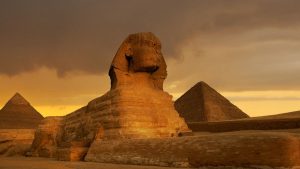
Location:
Giza Plateau, near Cairo
Overview:
The Pyramids of Giza are arguably the world’s most famous and iconic structures. It includes three main pyramids: the Great Pyramid of Khufu, the Pyramid of Khafre, and the Pyramid of Menkaure, along with the enigmatic Sphinx. These monuments were constructed as royal tombs for the pharaohs over 4,500 years ago, and they continue to intrigue historians and archaeologists with their precise engineering. The Great Pyramid of Khufu, the trio’s largest pyramid, is the ancient world’s last surviving wonder.
Karnak Temple

Location:
Luxor, Upper Egypt
Overview:
Karnak Temple is among the most enormous religious complexes ever constructed. It was dedicated primarily to the Theban triad of Amun, Mut, and Khonsu. The temple was built and expanded over 2,000 years, with each pharaoh adding to its grandeur. The temple complex is famous for its massive Hypostyle Hall, with its forest of 134 giant columns that seem to reach the sky. The Tempel served as a place of worship and a powerful political and economic center.
Step Pyramid of Saqqara & Saqqara Necropolis
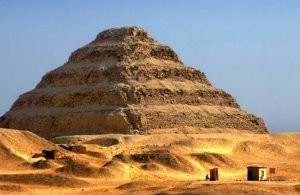
Location:
Saqqara, near Cairo
Overview:
The Step Pyramid of Djoser at Saqqara is the world’s first large-scale stone structure. Designed by the architect Imhotep for Pharaoh Djoser, this pyramid set the blueprint for all subsequent pyramids in Egypt. The surrounding Saqqara Necropolis was a centuries-old burial ground featuring numerous tombs and smaller pyramids. It is an essential site for understanding the evolution of pyramid construction in ancient Egypt.
Valley of the Kings

Location:
West Bank of the Nile, near Luxor
Overview:
The Valley is the final resting destination of Egypt’s New Kingdom pharaohs, including the famous tomb of Tutankhamun. The tombs are decorated with elaborate wall paintings depicting the soul’s journey through the afterlife. The tombs were constructed to secure the pharaohs’ safe passage into the afterlife and to protect their treasures from tomb raiders.
Valley of the Queens
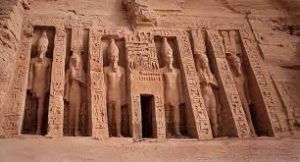
Location:
West Bank of the Nile, near Luxor
Overview:
The Valley was the burial location consecrated for the wives of pharaohs, princes, and other royal family members. Queen Nefertari’s tomb, the beloved wife of Ramses II, is the most famous in this valley. Her tomb is renowned for its stunning wall paintings, among Egypt’s most well-preserved and vibrant. The artwork provides a glimpse into the religious beliefs and royal status of the queens of the New Kingdom.
Abu Simbel
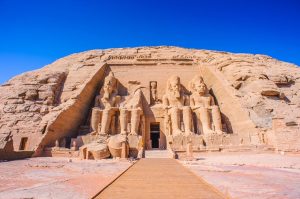
Location:
South Aswan, Upper Egypt
Overview:
Abu Simbel is one of Egypt’s most extraordinary ancient monuments, renowned for its grandeur and historical significance. This iconic site, carved directly into the rock, is a tribute to Pharaoh Ramses II’s power and devotion to the gods. Abu Simbel’s colossal statues and intricate carvings prove the architectural brilliance of ancient Egypt, drawing visitors from all over the world to witness its beauty and learn about its fascinating history.
The Abu Simbel complex consists of two massive temples: The Great One, dedicated to Ramses II himself, and the smaller Temple of Hathor, dedicated to his beloved queen, Nefertari. Built during the 13th century BCE, these temples were designed to showcase Ramses II’s divine status and to honor the gods Ra-Horakhty, Amun, and Ptah. The imposing façade of the Great Temple features four colossal statues of Ramses II, each standing at around 20 meters (66 feet) high, guarding the entrance.
The interior of the Great Temple is just as impressive, with a series of chambers adorned with elaborate carvings and hieroglyphics depicting scenes from Ramses II’s military victories, religious ceremonies, and his relationship with the gods. One of the most remarkable features of this temple is its alignment with the sun. Twice a year, on February 22 and October 22, the sun’s rays penetrate the temple’s innermost sanctuary, illuminating the statues of the gods seated within, except for Ptah, the god associated with the underworld.
Deir el-Bahri

Location:
West Bank of the Nile, near Luxor
Overview:
It is a complex of mortuary temples, the most prominent of which is the Temple of Hatshepsut. This magnificent structure was built into the cliffs of the Theban mountains and dedicated to the female pharaoh Hatshepsut. Its terraces, colonnades, and statues depict her reign and divine birth, showcasing her legacy as one of Egypt’s most powerful rulers.
Luxor Temple

Location:
Luxor, Upper Egypt
Overview:
Luxor Temple is one of the most impressive temples in Egypt, situated on the east bank of the Nile River. Unlike other temples dedicated to gods, Luxor Temple was primarily a place for the coronation of pharaohs. Built by Amenhotep III and later expanded by Ramses II, this temple features grand statues, a long avenue of sphinxes, and remarkable columns that create an atmosphere of ancient grandeur.
Philae Temple

Location:
Aswan, Upper Egypt
Overview:
The Temple was consecrated to the goddess Isis and is known for its fantastic architecture and intricate carvings. After the Aswan High Dam was constructed, the temple was relocated to the island of Agilkia to save it from the flooding waters of the Nile. It remains one of the best-preserved monuments in Egypt, reflecting the elegance of Egyptian and Greco-Roman styles.
Bent Pyramid and Red Pyramid

Location:
Dahshur, near Cairo
Overview:
The Pyramids, constructed by Pharaoh Sneferu, are in the Dahshur necropolis. The Bent Pyramid is unique due to its change in angle partway up, while the Red Pyramid, also known as the North Pyramid, is the first true smooth-sided pyramid. These structures marked a significant advancement in pyramid engineering and were crucial in developing the later pyramids at Giza.
Deir el-Medina
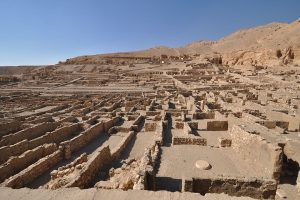
Location:
West Bank of the Nile, near Luxor
Overview:
The village of the workers and artisans built the tombs in the Valley of the Kings. This settlement provides a unique glimpse into the daily lives of the workers responsible for creating the pharaohs’ elaborate burial sites. The village includes well-preserved houses, tombs, and inscriptions that detail these ancient craftsmen’s social and economic life.
Temple of Hathor at Dendera
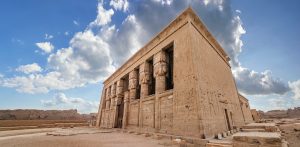
Location:
Dendera, Upper Egypt
Overview:
The Temple of Hathor at Dendera is one of the best-preserved temples in Egypt. Dedicated to Hathor, the goddess of love, music, and joy, the temple complex features stunning reliefs and astronomical ceilings. The vivid depictions of the zodiac and the famous Dendera light relief make this temple a highlight for anyone interested in ancient Egyptian mythology and celestial imagery.
Medinet Habu

Location:
West Bank of the Nile, near Luxor
Overview:
Medinet Habu is Ramses III’s mortuary temple and one of the most impressive temple complexes on the west bank of Luxor. It is renowned for its well-preserved reliefs depicting military campaigns, religious rituals, and daily life. The massive walls and columns of Medinet Habu are covered with intricate carvings that vividly illustrate Ramses III’s battles against the Sea Peoples.
Edfu Temple
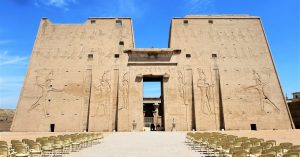
Location:
Edfu, Upper Egypt
Overview:
The Temple consecrated to the falcon god Horus, is among the best-preserved ancient temples in Egypt. It was Built during the Ptolemaic period; its walls are adorned with detailed inscriptions and hieroglyphs describing religious rituals, myths, and the conflict between Horus and Seth. The temple’s grand scale and well-preserved state make it a must-see destination for those exploring Egypt’s ancient wonders.
Memphis

Location:
Near Cairo, Lower Egypt
Overview:
It was the capital of ancient Egypt during the Old Kingdom and served as a significant center of politics and culture for over 3,000 years. Today, the site includes the ruins of temples, statues, and the famous alabaster sphinx. The colossal statue of Ramses II at Memphis is one of the highlights, showcasing the grandeur of this ancient capital.
Unfinished Obelisk
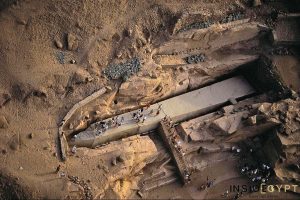
Location:
Aswan, Upper Egypt
Overview:
It is a remarkable piece of ancient engineering. Carved directly out of bedrock, it is the most giant known ancient obelisk, but it was abandoned when cracks appeared in the stone. Visiting this site provides insight into the incredible methods used by the ancient Egyptians to carve and transport these massive monuments.
Colossi of Memnon
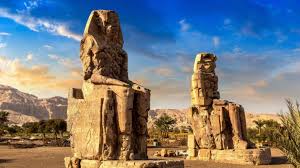
Location:
West Bank of the Nile, near Luxor
Overview:
Two massive statues of Pharaoh Amenhotep III used to guard the entrance to his mortuary temple. These statues are over 18 meters tall and have withstood centuries of natural disasters and human activity. The Colossi are known for the mysterious “singing” phenomenon that was heard coming from one of the statues at sunrise, which ancient Greeks believed to be the voice of Memnon.
Ramesseum
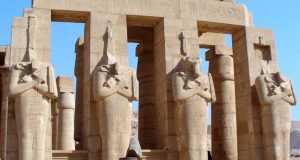
Location:
West Bank of the Nile, near Luxor
Overview:
It is the mortuary temple of Ramses II, one of Egypt’s most powerful pharaohs. Known for its grand design and magnificent statues, the temple features extensive wall reliefs depicting scenes of Ramses II’s military victories, including the famous Battle of Kadesh. The Ramesseum is a tribute to the legacy and achievements of one of Egypt’s greatest rulers.
Kom Ombo
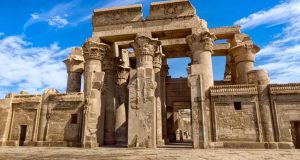
Location:
Kom Ombo, Upper Egypt
Overview:
The Temple is unique because it is consecrated of two gods: Sobek, the crocodile god, and Horus, the falcon god. The temple’s symmetrical design reflects this dual devotion, with twin halls and sanctuaries. Kom Ombo also features a fascinating collection of mummified crocodiles and inscriptions that provide insight into ancient Egyptian medicine.
Temple of Khnum at Esna
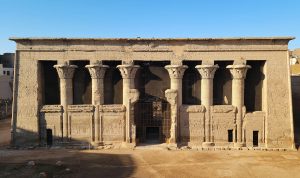
Location:
Esna, Upper Egypt
Overview:
The Temple of Khnum at Esna is a beautiful example of Ptolemaic and Roman architecture. Consecrated to the ram-headed god of creation, Khnum, it is known for its magnificent columns and detailed hieroglyphs adorning its walls and ceilings. The inscriptions include significant information about the religious festivals and rituals practiced during that time.
Frequently Asked Questions
What is the best time to visit these ancient Egyptian sites?
The ideal time to visit is during the cooler months, from October to April, to avoid the extreme heat of the summer.
Are these sites accessible for all travelers?
Most major sites, such as the Pyramids of Giza, Luxor Temple, and Karnak Temple, are well-equipped to accommodate visitors, but some remote locations may have limited accessibility.
Do I need a guide to explore these ancient sites?
While it’s possible to explore these sites on your own, hiring a guide can significantly enhance your understanding of each location’s history and significance.
Egypt’s ancient sites are more than remnants of a bygone era; they are living chronicles of a civilization that shaped human history. Each temple, pyramid, and monument tells a story of power, belief, and artistry that fascinates people from all corners of the globe. Whether you’re a history buff, an archaeology enthusiast, or a curious traveler, these must-see sites offer an unforgettable journey into the heart of ancient Egypt.
